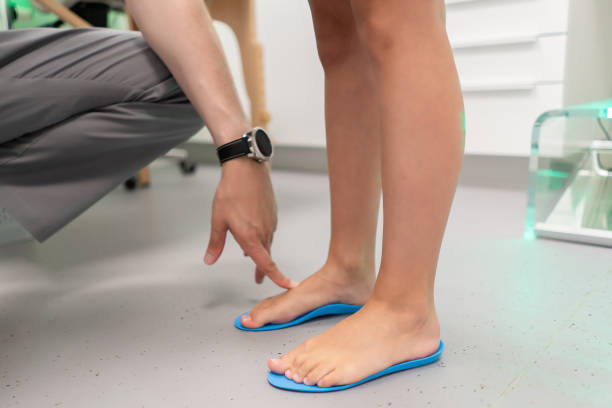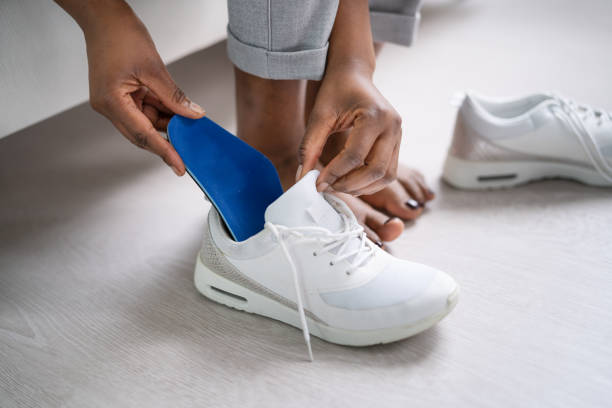If you suffer from foot pain, you may need to get custom orthotics for your feet. They cost more than over-the-counter insoles but can provide much more relief and support for your feet.
When shopping for shoes, be sure to take your orthotics with you and walk around in the shoes you plan on buying. They will need to fit with the shoe style you wear most often.

How to Measure Your Feet
The process of buying the right shoes can be frustrating if you don’t know how to measure your feet properly. The good news is that it’s not difficult to do, and it only takes a few minutes.
Start by tracing your foot on a blank sheet of paper while standing upright, with a slight bend in the knees for the most accurate measurement. It’s a good idea to have someone help you for this part so that you can get the most accurate measurements possible. Next, use the shoe size conversion charts on this page to convert your tracings to a shoe size. Finally, be sure to check the width of your feet by measuring across the widest point on each foot.
You may also want to make a note of the length of your foot, from the heel to the tip of the longest toe. This is especially important if you plan to wear your orthotics with any footwear that doesn’t have enough space for them.
Keep in mind that your feet can swell throughout the day, so it’s best to measure them at the end of the day when they are likely at their largest. Once you’ve figured out your shoe size, be sure to take into account the fact that some brands have different sizing charts than others.
What Type of Orthotics You Need
Orthotics are shoe inserts that are worn inside of shoes to help alleviate problems with the way you stand, walk or run. They can also be used to relieve foot pain from conditions such as diabetes, plantar fasciitis and arthritis.
There are several types of orthotics on the market that you can buy without a prescription. They typically come in gel, plastic or foam and can be chosen based on your shoe size or the type of foot problem you have (e.g. heel pain, arch pain). They may also be tailored to a specific sport or activity.
If you’re looking for more than an over-the-counter option, podiatrist in Albany, WA can help you to get a prescription for custom orthotics. They’re usually made from a mold of your feet and provide more support than over-the-counter options.
Custom orthotics are more expensive than over-the-counter shoe inserts, but they can be covered by your health insurance plan if you have a doctor’s prescription. They can also be purchased with money from a Flexible Spending Account (FSA) or Health Reimbursement Arrangement (HRA).
If you’re not sure what type of orthotics you need, schedule a call to chat with us! We can tell you if custom orthotics are right for you, and create a care plan that will help you get back to doing all the things you love.

Finding the Right Orthotics for You
Orthotic shoe inserts can help prevent physical pain, improve balance and posture and reduce bunions, calluses and corns. They are expensive though and typically not covered by health insurance, so it’s important to get the right pair for you.
Custom orthotics Albany are mass-produced to fit the ‘average’ foot and may not be the best for your feet. They may also worsen your condition by increasing pressure on the foot, ankle, knee or back. Investing in custom orthotics from a podiatrist or non-surgical foot specialist provides you with a medical evaluation and a proper fitting. They are also a better option for those who require a high level of rigidity and support or have specific foot conditions like flat feet or a high arch.
The type of material used in the construction of orthotics is another factor to consider. Plastics like polyolefins and elastomers are a common choice as they are rigid enough to control injury-producing foot motion, yet flexible and comfortable for use in shoes. Soft materials like neoprene and open- and closed-cell foam are also commonly used to provide cushioning and add comfort.
How to Fit Orthotics
Orthotics are prescription medical devices that can be a great investment for your foot health. They come with the medical evaluation, custom fit, and quality materials that are designed to last. They are more expensive than over-the-counter shoe inserts but many insurance plans cover the cost of orthotics.
It is important to follow your doctor’s break-in program for orthotics. Your feet will take time to adjust to the new “foot posture”. The new orthotics may feel uncomfortable or even painful at first. This is normal and should not persist for more than three weeks. If you experience discomfort beyond this point, call your physician or visit a podiatrist for an adjustment to the orthotics.
You should only use your orthotics in shoes that have enough volume for the additional foot support. Most athletic shoes have room for an orthotic but dress shoes and hiking boots typically do not. If you need to wear your orthotics in a shoe that is not a good fit, trim the soft top cover of the orthotics with scissors at the “toe end” to reduce wrinkling. This can be done in clinic at Firefly or at home using a template from your old shoe inserts or footbed.
When attempting to remove the orthotics from your shoes, you should be careful not to pull on the soft top cover or you could ruin the molded arch support. The best way to remove your orthotics is to place them in front of a chair with the back of the heel resting on the seat. Then carefully slide your foot in between the back of the heel support and the seat




